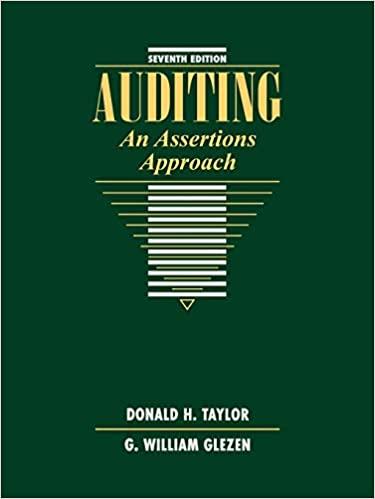Several years ago, Prescott Need opened a sporting goods store and invested heavily in a variety of
Question:
Several years ago, Prescott Need opened a sporting goods store and invested heavily in a variety of inventory, including fishing rods, golf clubs, and a specialized brand of snow ski. He also secured a large loan from a local bank by using a personal relationship with one of the loan officers and pledging most of his equipment. The loan officer did not require any type of audit for the first note, nor did she specifically indicate that an audit might be necessary to secure additional credit. Mr. Need leased several hundred square feet of empty, but expensive, space in the middle of the town's most prestigious mall. He spent several thousand dollars the first year on prime- time television advertising and half-page spreads in the local newspaper. He used much of his original cash investment on expensive inventory, equipment that he did not secure on credit, advertising, lease costs, and payroll to hire half a dozen experienced salespeople. During the first year, revenues were higher than anticipated because many of Mr. Need's friends bought their merchandise from him as personal favors and because economic times were good and numerous customers were planning expensive vacations. But in the second year a recession set in, and potential customers began to spend money for essentials rather than for vacation or recreational purposes. Revenues dropped noticeably, but expenses remained high because of the fixed costs, such as interest, rent expense on the building space. and salaries of the salespeople. Near the end of the second year, Mr. Need approached Susan Furnish, a local CPA, about hiring her to provide some services for his company. Required:
a. Discuss five possible services that Ms. Furnish might provide for Mr. Need and the reasons why each one might be beneficial. After due consideration, Mr. Need decided to hire Ms. Furnish's brother-in-law as his bookkeeper. He told Ms. Furnish that he might engage her as an auditor if any additional bank credit was necessary and the bank required an audit. Anticipating that he might have to extend and increase his bank loan, Mr. Need instructed his bookkeeper to "use whatever acceptable accounting methods are available to show the largest net income, the highest asset base, and the most favorable current ratio possible." The bookkeeper did this by (1) changing from a specific identification method of computing inventory to the first-in first- out (FIFO) method, thus charging to cost of goods sold many old and less expensive items of inventory, (2) changing from accelerated depreciation of equipment to the straight-line method, (3) capitalizing many supply items that had previously been expensed, and (4) re- classifying the bank note as a long-term liability on the assumption that it could be renewed for two more years. Near the end of the year, Mr. Need asked for an extension of the bank note and an increase in the line of credit. The loan officer stated that an audit of Mr. Need's sporting goods company would be necessary. The audited financial statements should be submitted to the bank before the loan extension could be considered. Mr. Need asked Ms. Furnish to conduct the audit. Ms. Furnish, who was aware that Mr. Need had changed some of his accounting methods, agreed to consider the request.
Required:
b. Describe the factors Ms. Furnish should consider before accepting the audit. In your discussion, distinguish between the obligations Ms. Furnish would have to (1) her client, Mr. Need, and (2) the bank, which is the third party. Ms. Furnish decided to perform the audit, but she informed Mr. Need that it would be necessary to take a close look at the accounting methods used to compile the financial statements of the company. During the audit, Ms. Furnish discovered numerous clerical errors, all of which the bookkeeper reluctantly corrected. Many hours were spent arguing the merits of the accounting methods used by Mr. Need, including the classification of the note as a long-term liability. Ms. Furnish neglected to read a provision of the note that specified that if a current ratio of 2 to 1 was not maintained, the bank had the right to demand payment of the note. The audited financial statements that Ms. Furnish gave to the bank, along with her audit report, showed an acceptable current ratio because the note was classified as long term. The note was extended, and Mr. Need was allowed to borrow additional amounts. Several months later, the sporting goods company declared bankruptcy and filed for protection from creditors under Chapter 11 of the bankruptcy laws. Required:
c. Should Ms. Furnish have conducted the audit? Give reasons for and against her accepting the audit.
d. What specific auditing standards did Ms. Furnish violate? Give reasons for your answers.
Step by Step Answer:

Auditing An Assertions Approach
ISBN: 9780471134213
7th Edition
Authors: G. William Glezen, Donald H. Taylor





